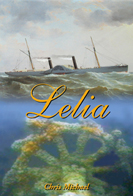
Book is 158 pages with many colour illustrations. First published 2004. Price £9.50. In stock.
Chris Michael, author of "Wrecks of Liverpool Bay", has explored shipwrecks both as a diver and by researching the archives. In 1997 he was diving on a wreck he had discovered in Liverpool Bay when he found a bronze bell, inscribed "LELIA 1864"
When the Lelia left Liverpool on her maiden voyage on 14 January 1865, among those aboard were Arthur Sinclair, a Commander in the Confederate Navy, and Thomas Miller, representative of his family's Liverpool shipbuilding company which had built her. Each of them had become embroiled in the unfolding of the American Civil War and their paths converged that day in Liverpool.
This book recounts the events that brought Arthur Sinclair and Thomas Miller togther. The Confederacy arranged for suitable ships to be built at Liverpool while attempting to avoid arousing the suspicions of Union spies. The author captures the atmosphere of innovation in Liverpool. Dramatic wrecks and rescues near Liverpool are described. Many blockade runners were built, some a success, some a failure.
The tragic maiden voyage of the Lelia is described in detail. Only a few of her crew survived and were able to gain shelter on the Northwest lightship. A Liverpool lifeboat being towed out to help them capsized with further loss of life. The causes of these disasters are discussed.
The discovery and present appearance of the wreck of the Lelia are reported and illustrated.
Appendices: Another wreck of a blockade runner; The crew and passengers of the Lelia; Registration of Lelia; Union spy reports; Board of Trade Enquiry; Board of Trade Report; Liverpool-built Blockade Runners ; Bibliography.
Published by Countyvise in association with LIVERPOOL MARINE PRESS
ISBN 1-901231-47-X
Countyvise ceased trading in 2015.
%%%%%%%%%%%%%%%%%%%%%%%%%%%%%%%%%%%%%%%%%%%%%%%%
Errata: page 44, information from the Bermuda Royal Gazette gives a date of 6 Sept (not 26 Sept) for the sinking of the Mary Celestia.
Additional Information: page 108, name of Cork Pilot who died is listed as Magnus Park. Most newspapers variously name the missing Cork Pilot as "Magnus Park", as "O'Brien" or as "unknown". Magnus Park was a Clyde pilot, who did not die in 1865. However Cork newspapers name the lost Cork pilot as Edward Sweeny, age 27, married.
Since 2019 the wreck of Lelia in Liverpool Bay is a protected
monument:
There are no restrictions on diver access to the wreck;
anyone may freely visit and dive the wreck (subject to notification to
the Port of Liverpool to ensure navigational safety). However, as the
Lelia is protected as a scheduled monument of national importance, it is
now a criminal offence to damage the wreck and undertake any intrusive
investigation without consent from Historic England.